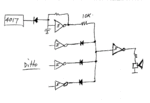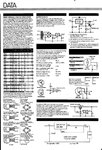ljcox
Full Member level 5
- Joined
- Feb 1, 2006
- Messages
- 252
- Helped
- 25
- Reputation
- 50
- Reaction score
- 23
- Trophy points
- 1,298
- Location
- Melbourne Australia
- Activity points
- 3,110
Attached are the circuit diagram, waveform diagram & a brief circuit description.
When you have this working, I'll suggest ways by which the tone can be smoothed and the output level increased.
When you have this working, I'll suggest ways by which the tone can be smoothed and the output level increased.



